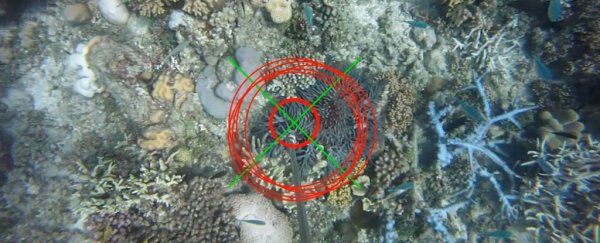Researchers have demonstrated that a new robot vehicle can successfully reduce the invasive habits of the Great Barrier Reef's worst pest – the crown-of-thorns starfish (COTS).
The autonomous underwater vehicle works by injecting a deadly dose of bile salts into the invasive pest, as reef trials have proven.
COTS are a huge threat to the Great Barrier Reef, responsible for 40 percent of the reef's total decline in coral cover.
The starfish feed on hard corals and, if the population is small, it can actually be good for diversity. But when there's an outbreak - COTS populations decimate all corals in the path.
And that's where the robot, named the COTSbot, comes in.
First announced last year - and dubbed the 'Terminator' of the reef- it's now been tested in the field.
In recent trials, researchers at the Queensland University of Technology (QUT) were able to monitor the COTSbots' efforts.
"We're very happy with COTSbot's computer vision and machine learning system," said QUT researcher, Feras Dayoub.
"The robot's detection rate is outstanding, particularly because COTS blend in very well with the hard, corals they feed on, and because the robot must detect them in widely varying lighting conditions and shapes as they hide among the coral."
COTSbot has only been in development for 18 months, so seeing it succeed so soon is a big deal for the researchers.
"It's always great to see a robot you built let off the leash, so to speak, doing the job it's intended for," said Matthew Dunbabin, another member of the QUT team.
"We couldn't be more ecstatic about how COTSbot has performed. The next generation will be even better and hopefully we can roll it out across the reef relatively quickly."
Last month, the COTSbot design won an upgrade with the people's choice vote for the Google Impact Challenge Australia.
In a project with the Great Barrier Reef Foundation, the upgraded design, called the RangerBot, will be smaller, and will add water quality sampling, coral cover monitoring, and a wide range of other features to its repertoire.
"It will stay under the water almost three times longer than a human diver, gather vastly more data, and operate in all conditions and all times of the day or night," said Dunbabin.
"I guess you could call RangerBot the Swiss Army Knife of marine robotics."
Google has just awarded the team AU $750,000 to make the upgrades a reality.
Unlike the current single-purpose marine robots, which can be expensive, manually-operated, and based on acoustic technologies, the RangerBot will use innovative vision-based technologies.
"We're very grateful the world shares our vision, so generously voting to protect reefs around the globe," said Anna Marsden, from the Great Barrier Reef Foundation.
"We want to empower communities on the front line of coral reef management with an affordable, versatile tool for monitoring and managing a wide range of marine issues."
As the researchers have only just finished their trials, they haven't yet published the COTSbot results, but we're looking forward to seeing what the team can do next.
The reef is under pretty huge strain right now and needs all the help it can get.
Queensland University of Technology is a sponsor of ScienceAlert. Find out more about their research.
